Toshiba Satellite L645D: Mobile AMD at 3GHz
by Dustin Sklavos on March 9, 2011 3:20 AM ESTAMD's Fastest Mobile Dual-Core
Okay, so that's not technically accurate: as of this writing there's a 45-watt Phenom II X620 BE running at 3.1GHz, but I challenge our readership to find a notebook employing that chip. That leaves us with the L645D enjoying the mobile equivalent of an Athlon II X2 250, a $60 desktop chip that still offers enough horsepower to do general computing fairly comfortably. Remember that AMD is the reigning budget champion on the desktop. So that said, can a 3GHz AMD chip close the gap with Intel's hardware?

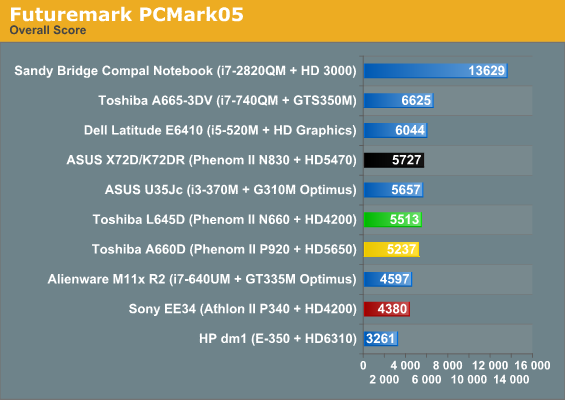
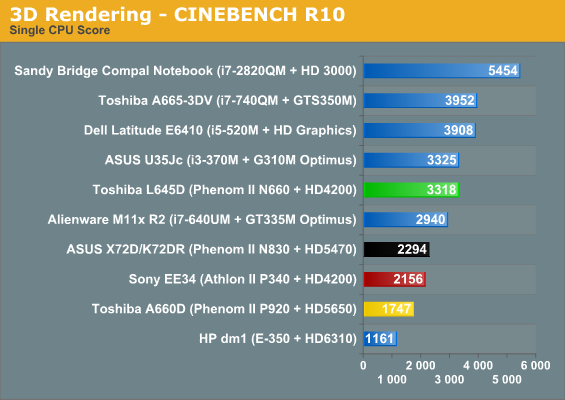
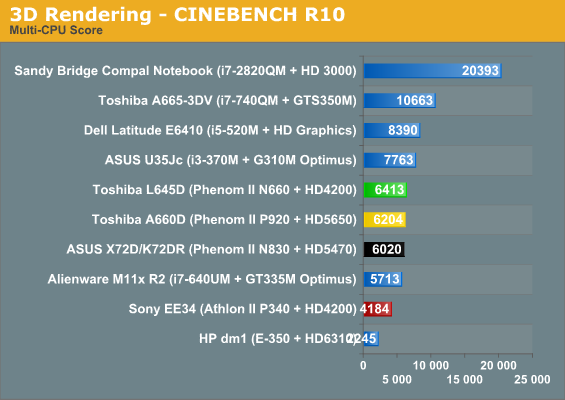

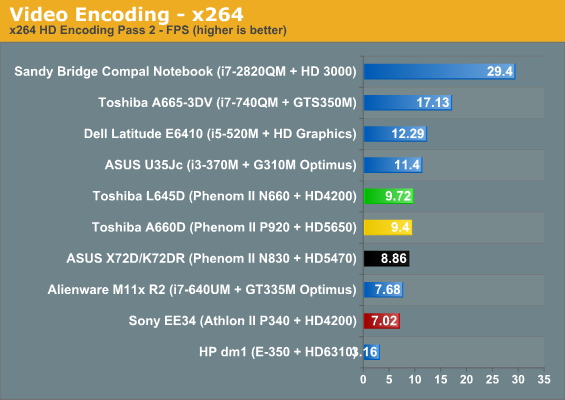
The two main take-aways here are that at 3GHz, AMD can at least hang with the i3-370M for the most part, and that AMD's mobile tri-core and quad-core chips were probably ill-advised. The extra headroom afforded by only having two cores allows the N660's 3GHz core clock to meet or beat the P920 with its four 1.6GHz cores and the N830 with its three 2.1GHz cores in even heavily threaded workloads. Ultimately the N660 is going to seem a little slow by comparison, but it's still offering a healthy amount of performance for most tasks and I wouldn't be completely aggravated doing more processor-intensive work (like video editing) on it.
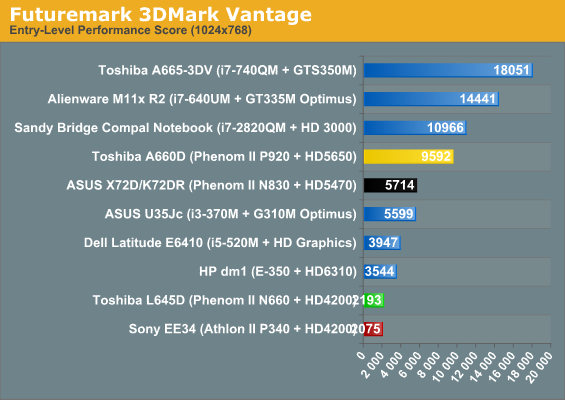
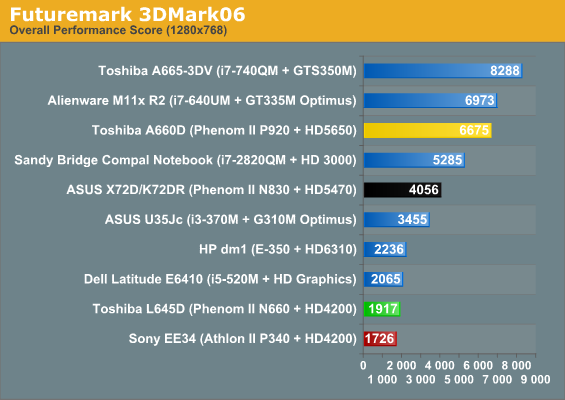
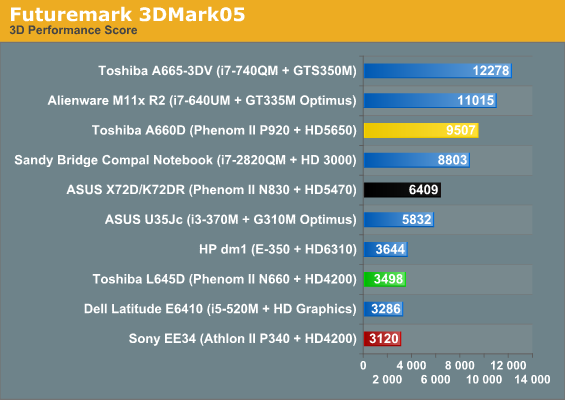
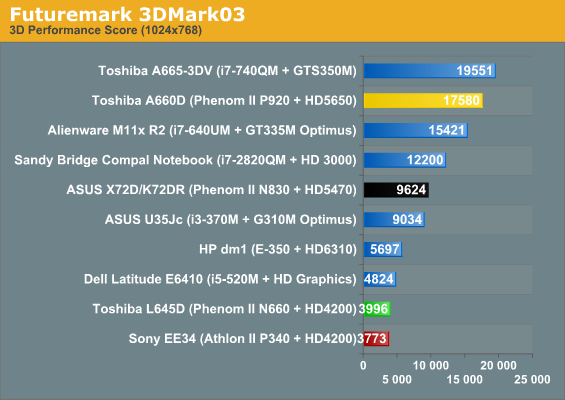
Unfortunately, though the extra 800MHz on the processor gives the L645D a leg up on Sony's EE34, the HD 4200/4250 starts to show its age again. Intel's HD graphics in the Dell Latitude post numbers on par with it in most disciplines (beating it soundly in 3DMark Vantage), but when we get to actual game testing we'll find that to be less the case.
This is where it would be good to point out that Toshiba loses one of the main points of leverage AMD's integrated graphics have over Intel's solutions: driver quality. As Jarred has mentioned in the past (and it does bear repeating), Toshiba has inexplicably opted out of AMD's mobile driver program, leaving you at their mercy. Sony doesn't get off any lighter: they opted out, too. There's really no good reason for this (especially since downloading the actual driver on another machine and then installing it on these notebooks still works), and it actively sabotages one of the strongest aspects of AMD's graphics hardware.










61 Comments
View All Comments
kmmatney - Wednesday, March 9, 2011 - link
Agreed. I have 4-year old 1930 x 1200 Dell, and had a look at a possible replacement. I couldn't find anything at Dell with more than 1080 pixels, and even that was hard to find and cost a lot. I have to give Apple credit for still using 1920 x 1200 resolution in their laptops. 1366 x 766 is total crap - especially with the extra vertical bloat in Windows 7.KiwiTT - Wednesday, March 9, 2011 - link
and on the 768 height, once you add the toolbars etc. You may only have half the screen left.Don't manufacturers do real user usability testing? If they did, they'd soon come to light that 768 is abysmally small.
bhima - Wednesday, March 9, 2011 - link
Your colorful language throughout the article made it a blast to read. Kudos Dustin!Dustin Sklavos - Thursday, March 10, 2011 - link
Thanks, much appreciated. :)helboy - Thursday, March 10, 2011 - link
"It seems like manufacturers almost deliberately cripple AMD-based notebooks."Had been my doubt also for the past one year or so!! Almost all the notebooks that carry the "not enough battery life" label after reviews,the battery provided will be of inferior capacity.AND the reviewers mostly ignore this fact when highlighting poor backup.I wonder whether winning the anti-trust case is helping AMD much in the marketing war.
cdeeter - Thursday, March 10, 2011 - link
+1 Yeah what's the deal with giving AMD systems smaller batteries? They are using the same chassis so use the same battery!silverblue - Thursday, March 10, 2011 - link
I can just imagine Intel realising they can't use one method to push AMD out of the market and then deciding to use another, albeit more subtle method. :P After all, battery life is king for a lot of people, so you need to prove those claims of long running times...And anyway, on an unrelated note, isn't it about time AMD got a stupid jingle for people to associate their products with? Everyone knows the Intel jingle.
jackylman - Thursday, March 10, 2011 - link
I picked up my new baby at a liquidation sale for the same price. It has the same CPU/GPU combo, but a 15.6" screen, webcam, gigabit LAN. On the downside, the hard disk is smaller (500GB) and no Blu-ray, but I'd rather have a bigger screen and a webcam.fumigator - Thursday, March 10, 2011 - link
Despite all the criticism, I like this laptop. Thanks for the great review.Only thing I would like to say is that I miss somehow the lack of nvidia chipsets on laptops.
I've owned an MSI VR630 that came with a geforce 9100 IGP and Turion X2 RM70 and I miss it all day. It was simply superb.
Later on the ATI 3200s and 4200s IGP started to pop up like maries and somewhat the 9100 started to look old. But even those MSI that came with Nforce 8200 and intel Core solutions were far better than any HD4500 based notebook. Lets say, MSI CR400, CR500, CR600 all came with Nforce 8200 and Intel something (Celeron dual core / Pentium dual core / Core 2 Duo etc, depending on submodel) Now they are all discontinued and nobody did serious reviews on them.
Moreover, i own an AM2+ motherboard with the Nforce chipset 8200 IGP as well, and I can't complain.
swaaye - Monday, March 14, 2011 - link
My mom wanted a notebook with a Bluray drive because she travels a lot for work and lives in a hotel for days at a time. So it's her mobile media center. I found a $600 Sony with a 2.0 GHz Core 2, 4GB and GMA 4500 something like 18 months ago.This Toshiba seems like the latest edition of that kind of thing. For what these are used for the performance might not even be tangibly different.